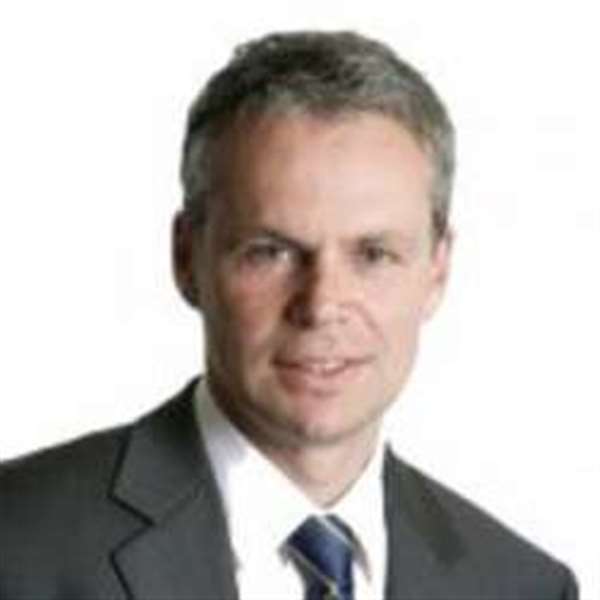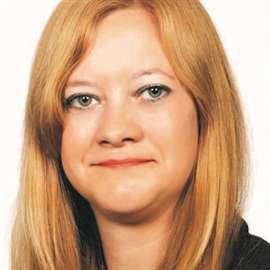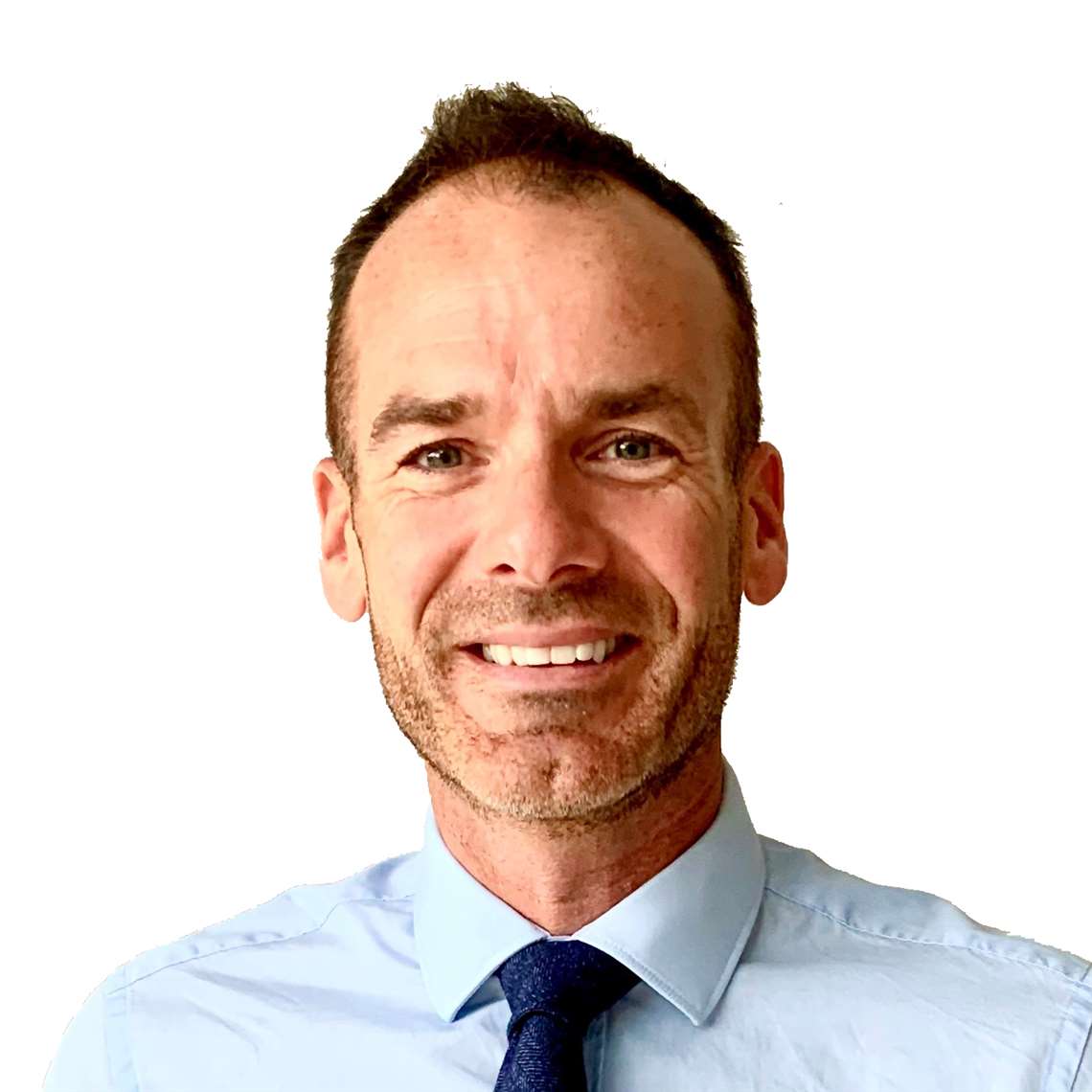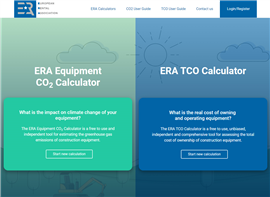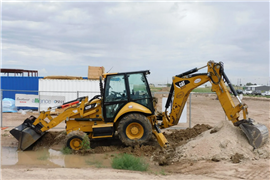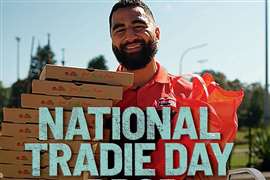Spreading the load: How cranes giant Palfinger wants to take its access platform business to the next level
28 July 2025
Best known around the world for its articulated loader cranes, Austrian engineering group Palfinger is betting on growing its access division as part of an ambitious diversification strategy. Euan Youdale speaks to Alexander Susanek, chief operating officer and Walter Haberl, product line leader for aerial work platforms to find out more.
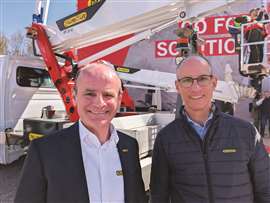 Alexander Susanek, chief operating officer, and Walter Haberl, product line leader for Aerial Work Platforms at Palfinger. Photo: KHL
Alexander Susanek, chief operating officer, and Walter Haberl, product line leader for Aerial Work Platforms at Palfinger. Photo: KHL
Palfinger, the Austrian engineering group is known around the world for its cranes.
The Salzburg-based manufacturer, founded in 1932, produces more than 100 models of truck-mounted articulated loader cranes and is easily considered the market leader in the segment.
Yet, despite this specialism, Palfinger, which also produces marine lifting solutions and truck-mounted forklifts, is looking to further diversify its business by intensifying its global push in the aerial platform market.
Palfinger says the group’s aerial work platforms (AWPs) unit is set to become a pillar of growth, with new investment earmarked for key regions including North America and India.
“Access is an increasingly important product line for Palfinger,” says Alexander Susanek, chief operating officer. “And we want to grow it.”
The access division, while historically overshadowed by the company’s core crane business, is now a strategic priority. “We have a strong production and service network and capabilities that we have built over the years with our cranes, so we can take a lot of this knowledge and experience to bring platforms to the next level,” adds Walter Haberl, product line leader for Aerial Work Platforms.
Global ambitions
The company’s main European production site for aerial platforms is located in Löbau, Germany. Investments there are designed to lift capacity and streamline manufacturing. Yet Palfinger’s ambitions are global.
“What is really important from a strategic standpoint is diversification,” says Susanek. “We see that as a big strength to make our company more resilient. We do not want to depend on one or two product lines alone or one or two regions, so we want to diversify not just across product lines, but across regions too.”
Yet with concerns about intensifying competition with Chinese produced products and mounting worries about trade tariffs, is this really the time to expand in the sector? Susanek says it is because the group’s diversified portfolio can provide ballast in turbulent markets.
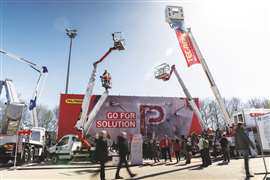 The Palfinger stand at Bauma. Photo: KHL
The Palfinger stand at Bauma. Photo: KHL
“When we saw weak demand in Europe, we could compensate for it because we were strong in North America – our marine business, which is a worldwide business, developed very strongly in revenue and profitability,” Susanek adds.
“And we have product lines like truck mounted forklifts for example – and presented a complete new range in the last two years. So, we will have some good pillars to place our business on, especially in these times when we don’t know what will happen next.”
While Palfinger does not disclose the platforms unit’s share of group revenues, executives describe it as “a very strong business and a very big business.”
“It’s a very flexible product that can be used for many applications,” said Haberl.
At the heart of Palfinger’s strategy is a commitment to localisation—what it calls producing “in the region for the region”—as a hedge against supply chain disruption and shifting trade dynamics.
“For us it is very important to be close to market,” said Susanek. “Generally, we follow the philosophy of producing in the region for the region, and in these uncertain times that proves to be a strength.”
In North America, Palfinger is enhancing its Oklahoma City plant, which serves as the manufacturing base for local platform production. “There is more to come, and strong focus on developing the plant itself,” Susanek said. “We have a lean initiative and have taken big steps to increase efficiency in production and increase quality, as well as investing a lot in our service network.”
With more than 1,200 employees in the US and three manufacturing sites, the company sees itself as a domestic operator. “So, we feel like a US company. We produce in the region for the region and of course that includes our in-house production and extends throughout the whole supply chain.”
Local production is also a practical necessity. Many vehicle-mounted platforms require integration with region-specific chassis to comply with national road regulations.
Palfinger is now laying the groundwork for expansion in Asia, starting with a new manufacturing facility in India—an investment projected at €25 million.
Indian facility
“India is one of the growth markets of the coming years and platforms will be an important part of that,” says Haberl. “It has a very vibrant economy with a lot of growth potential so we decided to start an operation there. We have sold in India for many years and we have a sales team which is well established and know the market very well.”
The company is currently in the process of securing a site, with construction expected to begin by year-end. Production is targeted for 2027, with output including loader cranes, platforms, and hook loaders.
“I spent some time in India recently and when you drive through the cities you see big investments in infrastructure, and you see a lot of platforms as well, including many of ours,” Susanek notes. “We are convinced that being a local manufacturer opens up a lot of doors in India – you are close to the market and people appreciate it if you work close to the market.”
The site will serve the domestic market primarily, but some exports to other Asian countries are planned. However, the company has no intention of developing entirely new product lines for the region. “What we do see is that a lot of our products are already interesting for the Indian market. Therefore, you will see some localization in their design but you will not see a whole new product line.”
With the Chinese economy slowing, the company also sees an opportunity to differentiate based on service quality and lifecycle value, rather than price alone. “It is not just about the purchase price alone,” says Susanek. “They expect performance reliability and service to provide up-time at a high level - and you cannot provide that just with delivering a cheap product. We are convinced we have a strong service network close to our customers supporting them in their business.”
New Hybrid Models Unveiled at Bauma 2025
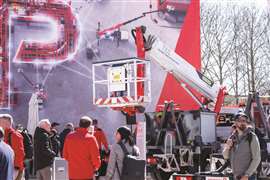 Palfinger exhibits its telescopic TEC range at Bauma 2025. Photo: KHL
Palfinger exhibits its telescopic TEC range at Bauma 2025. Photo: KHL
At Bauma 2025, Palfinger introduced a new generation of 3.5-tonne GVW hybrid truck mounts, featuring modular components and electric-drive readiness.
“We have put a lot of effort into performance improvements and modularity making maintenance easier than ever,” said Susanek.
The range spans working heights from 19m to 28m and replaces the previous series in this weight class.
In parallel, the company reopened its Löbau facility in 2024 as the European hub for AWPs, with a focus on the new TEC series.
“To support this, we have optimized key parts of our manufacturing lines, enhancing production efficiency and accelerating the development of our expertise on-site.”
The four-model TEC telescopic range—suitable for trucks up to 10.5 tonnes—was represented at Bauma by the PT 28 T and the PT 22 TJ. The PT 28 T offers fully electric operation with a 28m reach, while the PT 22 TJ, installed on an Iveco eDaily, features a compact design and flexible jib aimed at urban and industrial use.
Palfinger’s battery-powered pack allows platforms to operate throughout a typical workday with the truck engine switched off, reducing emissions, noise and wear.
This makes the machines suitable for low-emission zones, noise-sensitive areas such as hospitals, or even indoor applications. Two additional models—PT 25 TJ, with enhanced lateral reach, and the lighter PT 19 TJ, mounted on a 4.25-tonne Ford eTransit—round out the new range.
STAY CONNECTED



Receive the information you need when you need it through our world-leading magazines, newsletters and daily briefings.
CONNECT WITH THE TEAM
